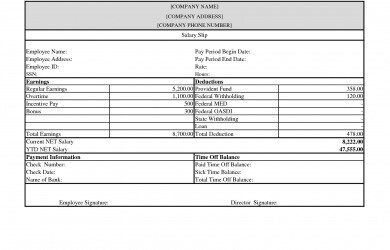
Depreciation expense gets closed, or reduced to zero, at the end of the year with other income statement accounts. Since accumulated depreciation is a balance sheet account, it remains on your books until the asset is trashed or sold. We credit the accumulated depreciation account because, as time passes, the company records the depreciation expense that is accumulated in the contra-asset account. However, there are situations when the accumulated depreciation account is debited or eliminated.

Instead, accumulated depreciation is the way of recognizing depreciation over the life of the asset instead of recognizing the expense all at once. Company A buys a piece of equipment with a useful life of 10 years for $110,000. The equipment is going to provide the company with value for the next 10 years, so the company expenses the cost of the equipment over the next 10 years.
Is Accumulated Depreciation a Debit or Credit?
Accumulated Depreciation is credited when Depreciation Expense is debited each accounting period. Accumulated depreciation is used instead of a direct reduction of the fixed assets account, so that readers of the financial statements can see that there are fixed assets on the books, and the original amount of this investment. Otherwise, only presenting a net book value figure might mislead readers into believing that a business has never invested substantial amounts in fixed assets. For year five, you report $1,400 of depreciation expense on your income statement. The desk’s net book value is $8,000 ($15,000 purchase price – $7,000 accumulated depreciation). Because the depreciation process is heavily rooted with estimates, it’s common for companies to need to revise their guess on the useful life of an asset’s life or the salvage value at the end of the asset’s life.
A Beginner's Guide to Using Contra Asset Accounts - The Motley Fool
A Beginner's Guide to Using Contra Asset Accounts.
Posted: Wed, 18 May 2022 16:59:21 GMT [source]
Finally, depreciation is not intended to reduce the cost of a fixed asset to its market value. Instead, depreciation is merely intended to gradually charge the cost of a fixed asset to expense over forecast your business's profits and losses with a rolling budget its useful life. Accumulated depreciation is a direct result of the accounting concept of depreciation. Depreciation is expensing the cost of an asset that produces revenue during its useful life.
Overview: What is accumulated depreciation?
Hence, the amount of accumulated depreciation at the end of the third year is $3,000 which will be included in the balance sheet as the contra account for the cost of equipment. Likewise, the net book value of the equipment is $2,000 at the end of the third year. Depreciation expense account is an expense on the income statement in which its normal balance is on the debit side.
For example, on Jan 1, the company ABC buys a piece of equipment that costs $5,000 to use in the business operation. The company estimates that the equipment has a useful life of 5 years with zero salvage value. The company’s policy in fixed asset management is to depreciate the equipment using the straight-line depreciation method. Assume that a company purchased a delivery vehicle for $50,000 and determined that the depreciation expense should be $9,000 for 5 years. Therefore, after three years the balance in Accumulated Depreciation will be a credit balance of $27,000 and the vehicle's book value will be $23,000 ($50,000 minus $27,000). Subtracting accumulated depreciation from an asset's cost results in the asset's book value or carrying value.
- The intent behind doing so is to approximately match the revenue or other benefits generated by the asset to its cost over its useful life (known as the matching principle).
- On the other hand, if the cash received/receivable/sale proceeds is higher than NBV, an income is recorded in the books of accounts as shown in the table.
- This is done by adding up the digits of the useful years, then depreciating based on that number of year.
- Note that in year 10, the accumulated depreciation has reached the highest point of depreciable amount.
- To understand the concept of "accumulated depreciation," it's helpful to be familiar with the depreciation mechanism.
The accounting for depreciation requires an ongoing series of entries to charge a fixed asset to expense, and eventually to derecognize it. These entries are designed to reflect the ongoing usage of fixed assets over time. Straight line depreciation applies a uniform depreciation expense over an asset’s useful life. To calculate annual depreciation, divide the depreciable value (purchase price – salvage value) by the asset’s useful life. The desk’s annual depreciation expense is $1,400 ($14,000 depreciable value ÷ 10-year useful life).
Cash Flows and Depreciation
However, when your company sells or retires an asset, you’ll debit the accumulated depreciation account to remove the accumulated depreciation for that asset. Accumulated depreciation is a balance sheet account that reflects the total recorded depreciation since an asset was placed in service. Let's say as an example that Exxon Mobil Corporation (XOM) has a piece of oil drilling equipment that was purchased for $1 million.
More so, accumulated depreciation is not a debit but a credit because fixed assets have a debit balance. Therefore, accumulated depreciation must have a credit balance to be able to properly offset the fixed assets. Thus, it appears immediately below the fixed assets line item within the long-term assets section of the balance sheet as a negative figure. Contra accounts are recorded with a credit balance that decreases the balance of an asset.
Why does accumulated depreciation have a credit balance on the balance sheet?
Conversely, accumulated depreciation as a contra asset account will increase with a credit and a debit will decrease its value. Accumulated depreciation is not a debit but a credit because it aggregates the amount of depreciation expense charged against a fixed asset. On the balance sheet, the accumulated depreciation is paired with the fixed assets line item, so that the combined total of the two accounts reveals the remaining book value of the fixed assets.
How to Record a Depreciation Journal Entry: Step By Step - The Motley Fool
How to Record a Depreciation Journal Entry: Step By Step.
Posted: Wed, 18 May 2022 16:58:26 GMT [source]
As mentioned, the accumulated depreciation is not an expense nor a liability, but it is a contra account to the fixed assets on the balance sheet. Likewise, if the company’s balance sheet shows the gross amount of fixed assets which is the total cost, the accumulated depreciation will show as a reduction to the balance of fixed assets. Each year, the depreciation expense account is debited, expensing a portion of the asset for that year, while the accumulated depreciation account is credited for the same amount.
Now by using both straight-line and reducing balance methods for calculating depreciation and the treatment of accumulated depreciation. For every asset you have in use, there is an initial cost (aka original basis) and value loss over time (aka accumulated depreciation). Accumulated depreciation of an asset is an important financial metric for the business as it reduces a firm’s value on the balance sheet. Accumulated depreciation for the desk after year five is $7,000 ($1,400 annual depreciation expense ✕ 5 years). The same is true for many big purchases, and that’s why businesses must depreciate most assets for financial reporting purposes.
Accounts like accumulated depreciation help paint a more accurate picture of your business’s financial state. A commonly practiced strategy for depreciating an asset is to recognize a half year of depreciation in the year an asset is acquired and a half year of depreciation in the last year of an asset’s useful life. This strategy is employed to more fairly allocate depreciation expense and accumulated depreciation in years when an asset may only be used part of a year. Accumulated depreciation is a real account (a general ledger account that is not listed on the income statement). The balance rolls year-over-year, while nominal accounts like depreciation expense are closed out at year end.
Therefore, leading to a decrease in the book value of fixed assets of the company until the book value of the asset becomes zero. Since fixed assets on the balance sheet have a debit balance, by recording accumulated depreciation as a credit balance, the fixed asset can be offset. Therefore, the accumulated depreciation as a contra-asset account offsets the value of the asset that it is depreciating and as such is reported as a negative balance on the balance sheet under the long-term assets section. To record depreciation expense, a corporate accountant debits the depreciation expense account and credits the accumulated depreciation account. As a contra-account, accumulated depreciation lowers an asset’s value over time, bringing this value to zero at the end of the resource’s useful life.

Net off is necessary to present a true and fair view because we do not decrease depreciation from the cost of an asset. Emilie is a Certified Accountant and Banker with Master's in Business and 15 years of experience in finance and accounting from corporates, financial services firms - and fast growing start-ups. It is important to note that an asset's book value does not indicate the vehicle's market value since depreciation is merely an allocation technique. He has authored articles since 2000, covering topics such as politics, technology and business. A certified public accountant and certified financial manager, Codjia received a Master of Business Administration from Rutgers University, majoring in investment analysis and financial management. The Dr. Charge will lead the expense amount to the Profit and Loss account, or you may call it the Statement of Comprehensive Income.
